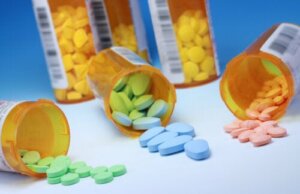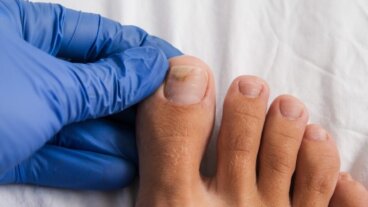Muscle Relaxant Drugs: 12 of the Most Used

There are two basic types of muscle relaxant drugs. Some are used to treat spasms (carisoprodol, chlorzoxazone, and cyclobenzaprine), and others are for spasticity (baclofen, dantrolene, diazepam).
These are sensitive drugs that require a prescription. The reason is that some of them can interact with other substances, as well as produce side effects.
In this article, we’ll learn what muscle relaxant drugs are, their purposes, precautions for use, and contraindications. It should be noted that the intention of this article is only informative.
What are muscle relaxant drugs and what are they used for?
As the name implies, these drugs are used in the treatment of certain muscle problems. Specifically, they’re recommended for spasms as well as spasticity.
Spasms or cramps refer to sudden, involuntary contractions of one or more muscles. These can be caused by accumulated tension and occur with pain.
In spasticity, on the other hand, the muscle feels stiff, making it difficult to flex a joint. It’s caused by lesions in the nerves involved in the movement. It can be a symptom of some conditions, such as multiple sclerosis, amyotrophic lateral sclerosis, and cerebral palsy.
Muscle relaxant drugs can help soothe or reduce pain and discomfort related to spasms and spasticity, even in clinical conditions such as irritable bowel syndrome. However, they don’t attack the root cause.
It should be noted that these drugs shouldn’t be interchanged, i.e., they cannot be administered in place of each other. Therefore, antispasmodics shouldn’t be used for spasms, although some antispasmodics (such as tizanidine), are also recommended in spasticity.
To find out more, read: 5 Remedies To Avoid Muscle Cramps
Commonly used antispasmodic muscle relaxant drugs
Antispasmodics act on the nervous system, producing a sedative effect, in the sense that they block or inhibit pain signals. It’s advisable not to use them for more than 2 to 3 weeks.
On the other hand, so far they haven’t proven to be more effective than non-steroidal anti-inflammatory drugs or acetaminophen, but they do have more side effects than these. Among the best known are the following.

1. Carisoprodol
Carisoprodol comes in 350-milligram (mg) tablets. It’s recommended for musculoskeletal disorders with pain caused by sprains, strains or other injuries. It can also be found in combination with aspirin or codeine.
2. Chlorzoxazone
Known under the brand names Parafon ® or Lorzone ®, chlorzoxazone is also used to relieve pain and contractions due to muscle tears or sprains. In treatment, it’s often used in conjunction with aspirin or analgesics such as acetaminophen.
3. Metaxalone
Commercially called Skelaxin ® or Metaxall ®. It’s administered orally and comes in 800 mg tablets. This muscle relaxant is effective, but relatively potent, so it should be taken in moderation.
4. Methocarbamol
The best-known trade name for this muscle relaxant is Robaxin®. It comes in 500 mg tablets. It’s considered ineffective for low back pain, as well as in cases of rheumatoid arthritis and cerebral palsy muscle problems.
The maximum dose in adults is 2 to 3 tablets 4 times daily (4 to 6 grams per day). But the dose should be adjusted for elderly people and patients with liver disease.
5. Orphenadrine
Norflex® is a muscle relaxant for oral administration. It has an anticholinergic effect and is therefore recommended for pain and to help with motor control in people with Parkinson’s disease.
6. Tizanidine
Tizanidine is an alpha-2 receptor agonist muscle relaxant that works in the spinal cord. It’s centrally acting and slows down the action of the brain and nervous system.
7. Cyclobenzaprine
Cyclobenzaprine is a tricyclic drug. It comes in various forms, usually 5 to 10 mg.
It’s administered 2 to 4 times a day, the maximum dose being 60 mg/day. It’s useful for pain, but not for spasticity or stiffness.
Another excellent article for you: Characteristics of Yurelax, a Muscle Relaxant
Commonly used antispastic muscle relaxants
The other group of muscle relaxants is made up of antispastics. These include the following.
8. Baclofen
Baclofen (Lioresal® ) is used for spasticity in multiple sclerosis. It’s supposed to work by blocking the nerve signals sent by the spine that trigger spasms.
9. Dantrolene
Known commercially as Dantrium®, dantrolene is also prescribed in cases of multiple sclerosis, as well as for muscle spasms caused by stroke, spinal cord injury and cerebral palsy. Unlike the former, it acts on skeletal muscle.
10. Diazepam
Diazepam (Valium ®) is a drug belonging to the benzodiazepine group. It’s used in depression and anxiety, and is also a muscle relaxant that helps to relieve spasms.
Other drugs prescribed as muscle relaxants
Apart from those already mentioned, some drugs may be recommended by health professionals to treat problems such as spasticity, without actually being muscle relaxants.
11. Benzodiazepines
Other benzodiazepines can help to relax muscles, due to their sedative effects. These include clonazepam and alprazolam.
12. Gabapentin
Gabapentin is an anticonvulsant. It also helps to relieve muscle spasticity, although its function is not fully understood.

Precautions and contraindications
Muscle relaxants interact with alcohol and other drugs. Therefore, concomitant use with opioid analgesics, psychotropics, and central nervous system depressants should be avoided.
Because of their sensitive use, a physician should be consulted in the following cases:
- Adults over 65 years old and under 18 years old
- Patients with mental disorders
- Liver disease and kidney failure
If the person is going to operate machinery, heavy equipment or perform any task that demands strength, precision and coordination, they mustn’t take them.
Side effects of muscle relaxants
Muscle relaxants can produce a variety of side effects. The most common are the following:
- Drowsiness and fatigue
- Dizziness or loss of balance
- Headaches
- Nervous agitation
- Difficulty concentrating or remembering things
Prolonged treatment with muscle relaxants should be avoided, as some can create dependence, as well as withdrawal syndrome.
All cited sources were thoroughly reviewed by our team to ensure their quality, reliability, currency, and validity. The bibliography of this article was considered reliable and of academic or scientific accuracy.
- Agencia Española de Medicamentos y Productos Sanitarios (s.f.). Ficha técnica Orfadin 2 mg cáspulas duras. Consultado el 24 de marzo de 2023. https://cima.aemps.es/cima/dochtml/ft/04303001/FT_04303001.html.
- Agencia Española de Medicamentos y Productos Sanitarios (s.f.). Prospecto Diazepam Normon 5 mg comprimidos. Consultado el 24 de marzo de 2023. https://cima.aemps.es/cima/dochtml/p/51208/P_51208.html.
- Agencia Española de Medicamentos y Productos Sanitarios (s.f.). Prospecto Robaxin 500 mg comprimidos. Consultado el 24 de marzo de 2023. https://cima.aemps.es/cima/dochtml/p/32899/Prospecto_32899.html.
- Agencia Española de Medicamentos y Productos Sanitarios (s.f.). Prospecto Sirdalud 2 mg comprimidos. Consultado el 24 de marzo de 2023. https://cima.aemps.es/cima/dochtml/p/58313/Prospecto_58313.html.
- Bolaños-Jiménez R, Arizmendi-Vargas, J., Calderón-Álvarez, J., Carrillo-Ruiz J., Rivera-Silva, G., Jiménez-Ponce, F. Espasticidad, conceptos fisiológicos y fisiopatológicos aplicados a la clínica. Revista Mexicana de Neurociencia, 12(3), 141-148. https://www.medigraphic.com/pdfs/revmexneu/rmn-2011/rmn113d.pdf.
- Bustos-Fernández, L. (2021). Síndrome de intestino irritable: la importancia de los antiespasmódicos. Revista Colombiana de Gastroenterología; 35(3), 338-344. http://www.scielo.org.co/pdf/rcg/v35n3/en_0120-9957-rcg-35-03-338.pdf.
- Cortés-Monroy, C., & Soza, S. (2019). Una mirada desde la medicina física y rehabilitación al dolor miofascial. Revista Médica Clínica Las Condes, 30(6), 428-435. https://www.sciencedirect.com/science/article/pii/S0716864019300951
- Chou, R., Peterson, K., & Helfand, M. (2004). Comparative efficacy and safety of skeletal muscle relaxants for spasticity and musculoskeletal conditions: a systematic review. Journal of pain and symptom management, 28(2), 140-175. https://www.sciencedirect.com/science/article/pii/S0885392404002155
- Delgado-Silveira E., Mateos-Nozal J., Muñoz, M. (2019). Uso potencialmente inapropiado de fármacos en cuidados paliativos: versión en castellano de los criterios STOPP-Frail (STOPP-Pal). Revista Española de Geriatría y Gerontología, 54(3), 151-155. https://revistamedica.com/cuidados-paliativos-criterios-stopp-frail/.
- González Gómez, C., Martínez Galdámez, M.E., Campello Márquez, E., Martín Pacheco, J.F., Álvarez García, A., & Arazo Guerrero, O.. (2017). Prevalencia de consumo de benzodiacepinas en un grupo de población militar. Sanidad Militar, 73(3), 184-186. https://scielo.isciii.es/scielo.php?script=sci_arttext&pid=S1887-85712017000300184
- LiverTox: Clinical and Research Information on Drug-Induced Liver Injury. (2012). National Institute of Diabetes and Digestive and Kidney Diseases.
- López Vantour, A., Aroche Arzuaga, A., Bestard Romero, J. & Ocaña Fontela, N. (2010). Uso y abuso de las benzodiazepinas. MEDISAN, 14(4). http://scielo.sld.cu/scielo.php?pid=S1029-30192010000400017&script=sci_arttext&tlng=pt
- Malanga, G., Reiter, R. D., & Garay, E. (2008). Update on tizanidine for muscle spasticity and emerging indications. Expert opinion on pharmacotherapy, 9(12), 2209–2215. https://www.tandfonline.com/doi/abs/10.1517/14656566.9.12.2209
- Martín-Aragón, S., Bermejo, P., Marcos, E. (2008). Relajantes musculares. Revisión. Farmacia Profesional, 22(8), 38-43. https://www.elsevier.es/es-revista-farmacia-profesional-3-articulo-relajantes-musculares-revision-13126019/.
- MedlinePlus (2019). Baclofeno. Consultado el 24 de marzo de 2023. https://medlineplus.gov/spanish/druginfo/meds/a682530-es.html.
- MedlinePlus (2017). Ciclobenzaprina. Consultado el 24 de marzo de 2023. https://medlineplus.gov/spanish/druginfo/meds/a682514-es.html.
- MedlinePlus (2019). Dantroleno. Consultado el 24 de marzo de 2023. https://medlineplus.gov/spanish/druginfo/meds/a682576-es.html.
- MedlinePlus (2020). Gabapentina. Consultado el 24 de marzo de 2023. https://medlineplus.gov/spanish/druginfo/meds/a694007-es.html.
- Neumeyer, J. (2022). Fármacos que se emplean en la enfermedad de Parkinson. En Lea & Febiger (Eds.),Principios de química farmacéutica (pp. 250–271). Reverté.
- Nirogi, R. V., Kandikere, V. N., Shukla, M., Mudigonda, K., Shrivastava, W., & Datla, P. V. (2006). Quantification of metaxalone in human plasma by liquid chromatography coupled to tandem mass spectrometry. Journal of analytical toxicology, 30(4), 245–251. https://pubmed.ncbi.nlm.nih.gov/16803662/
-
Otero-Romero, S., Sastre-Garriga, J., Comi, G., Hartung, H. P., Soelberg Sørensen, P., Thompson, A. J., Vermersch, P., Gold, R., & Montalban, X. (2016). Pharmacological management of spasticity in multiple sclerosis: Systematic review and consensus paper. Multiple sclerosis, 22(11), 1386–1396. https://doi.org/10.1177/1352458516643600
- Sánchez, C. (2002). Relajantes musculares y sus interacciones. Fármacos, 15(2), 25-33. https://pesquisa.bvsalud.org/portal/resource/pt/lil-343254.
- Stewart, J. & Janicki, C. (1987). Chlorzoxazone. Analytical Profiles of Drug Substances, 16, 119-144. https://www.sciencedirect.com/science/article/abs/pii/S0099542808605559
- Toth, P. & Urtis, J. (2004). Commonly used muscle relaxant therapies for acute low back pain: a review of carisoprodol, cyclobenzaprine hydrochloride, and metaxalone. Clinical therapeutics, 26(9), 1355-1367. https://www.sciencedirect.com/science/article/abs/pii/S0149291804802832
-
Turski, L., Schwarz, M., Turski, W. A., Ikonomidou, C., & Sontag, K. H. (1984). Effect of aminophylline on muscle relaxant action of diazepam and phenobarbitone in genetically spastic rats: further evidence for a purinergic mechanism in the action of diazepam. European journal of pharmacology, 103(1-2), 99–105. https://doi.org/10.1016/0014-2999(84)90194-8
- Vademecum (2015). Skelaxin tablet 800 mg. Consultado el 24 de marzo de 2023. https://www.vademecum.es/equivalencia-lista-skelaxin+tablet+800+mg-estados+unidos-m09ax-28003665-us_1.
- Vademecum (2015). Orfenadrina (citrato). Consultado el 24 de marzo de 2023. https://www.vademecum.es/principios-activos-orfenadrina+(citrato)-m03bc01
- Valenzuela, J., Alvarado, J. & Cohen, H. (2004). Un consenso latinoamericano sobre el síndrome del intestino irritable. Gastroenterología y Hepatología, 27(5), 325-343. https://www.elsevier.es/es-revista-gastroenterologia-hepatologia-14-articulo-un-consenso-latinoamericano-sobre-el-S0210570503704701?referer=buscador.
- Wagstaff, A.J. & Bryson, H.M. Tizanidine. Drugs 53, 435–452 (1997). https://link.springer.com/article/10.2165/00003495-199753030-00007#citeas
- Western New York Urology Associates. (15 de octubre de 2018). Metaxalona. Consultado el 31 de marzo de 2023. https://www.wnyurology.com/content.aspx?chunkiid=697456
This text is provided for informational purposes only and does not replace consultation with a professional. If in doubt, consult your specialist.








